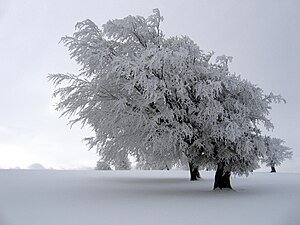Atmospheric icing

Atmospheric icing occurs in the atmosphere when water droplets freeze on objects they come in contact with. Icing conditions can be particularly dangerous to aircraft, as the built-up ice changes the aerodynamics of the flight surfaces, which can increase the risk of a stall. For this reason, on-board ice protection systems have been developed.
Water does not always freeze at 0 °C (32 °F). Water that persists in liquid state below this temperature is said to be supercooled, and supercooled water droplets cause icing on aircraft. Below −20 °C (−4 °F), icing is rare because clouds at these temperatures usually consist of ice particles rather than supercooled water droplets. Below −48 °C (−54 °F), supercooled water cannot exist, therefore icing is impossible.[1]
Icing also occurs on towers, wind turbines, boats, oil rigs, trees and other objects exposed to low temperatures and water droplets. Unmanned aircraft are particularly sensitive to icing.[2] In cold climates on land, atmospheric icing can be common as elevated terrain interacts with cold clouds.[3] Ice loads are a major cause of catastrophic failures of overhead electric power lines. Their estimation is, therefore, crucial in the structural design of power line systems[4] and can be done by numerical icing models that include meteorological data.[5]
See also[]
- Condensation
- Frost
- Hard rime
- Soft rime
- Icing (nautical)
References[]
- ^ Moore, Emily; Valeria Molinero (24 November 2011). "structural transformation in supercooled water controls the crystallization rate of ice". Nature. 479 (7374): 506–508. arXiv:1107.1622. Bibcode:2011Natur.479..506M. doi:10.1038/nature10586. PMID 22113691. S2CID 1784703.
- ^ Hann, Richard; Johansen, Tor (2020). "Unsettled Topics in Unmanned Aerial Vehicle Icing (EPR2020008 Research Report) - SAE Mobilus". saemobilus.sae.org. doi:10.4271/epr2020008. Retrieved 2021-02-14.
- ^ Yang, Jing; Jones, Kathleen F.; Yu, Wei; Morris, Robert (2012-09-08). "Simulation of in-cloud icing events on Mount Washington with the GEM-LAM". Journal of Geophysical Research: Atmospheres. 117 (D17): n/a. Bibcode:2012JGRD..11717204Y. doi:10.1029/2012jd017520. ISSN 0148-0227.
- ^ Farzaneh, M. (2008) Atmospheric Icing of Power Networks. Springer Science & Business Media, 2008, 381 p. ISBN 978-1-4020-8530-7
- ^ Makkonen, L. (2000) Models for the growth of rime, glaze, icicles and wet snow deposits on structures. Philosophical Transactions of the Royal Society of London A, 358 (1776): 2913-2939.
- Sources
- FAA (U.S.) Advisory Circular 20-113: Pilot Precautions and Procedures to be taken in Preventing Aircraft Reciprocating Engine Induction System and Fuel System Icing Problems
- FAA (U.S.) Advisory Circular 20-117: Hazards Following Ground Deicing and Ground Operations in Conditions Conducive to Aircraft Icing
- FAA (U.S.) Advisory Circular 20-147: Turbojet, Turboprop, and Turbofan Engine Induction System Icing and Ice Ingestion
- Wind Energy in Cold Climates: Icing on wind turbines
External links[]
| Wikimedia Commons has media related to Atmospheric icing. |
- Precipitation
